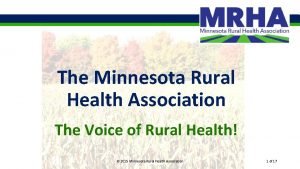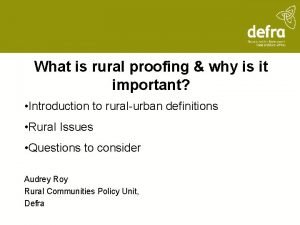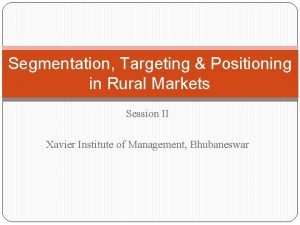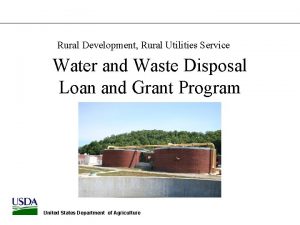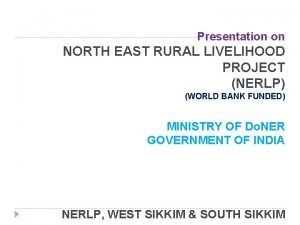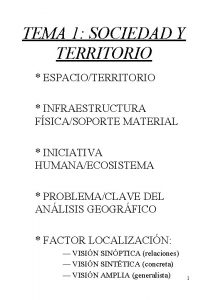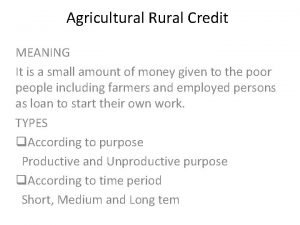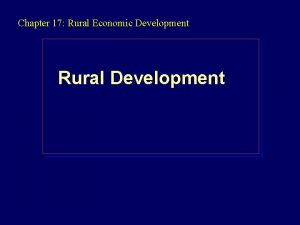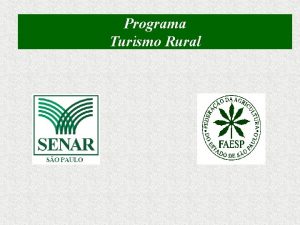Rural Finance Institutions n n n Institutions Organizational















- Slides: 15

Rural Finance - Institutions n n n Institutions Organizational structure Policies Outcome Innovations

Rural Finance - Institutions n Private moneylenders/traders/landlords - Promptness of services - supply loan and receive payments in variety of forms and size - No or hardly any marketable collateral - Interlinking of credit transaction - Successful use of borrowers’ credit records - Proper monitoring of loans - vary high interest rate - perpetual indebt ness of borrowers - still occupy a dominant role in rural financial market

Rural Finance - Institutions n Cooperative credit institutions - Separate institutions for short term and long term credit - Three tier structure for short term credit - State cooperative banks - District central cooperative banks - Primary agriculture credit societies

Rural Finance - Institutions n n n Registered under cooperative society act 1904 Financial partnership by state in 1954 Large membership but heterogeneous Peoples’ own organization Based on members’ contribution of funds PACS, FSS and LAMPS

Categories of PACS Features PACS FSS LAMPS Area Coverage Not less than 2000 hectares of cropped area Extending up to Block or population of 10, 000 A Block or a thesil Beneficiaries Farmers and other rural households Tribals Credit Business ST and MT loans for agriculture Multi-purpose credit ST/MT loans including consumption loans Non-credit Business Package of services Supply of farm inputs, PDS

Rural Finance - Institutions n n n The share of cooperatives in agriculture credit has declined from 77 percent in 1970 -71 to about 30 per cent The borrowing members are only 24 percent The average deposit per society is as low as Rs. 650 in Bihar to Rs. 7000 in West Bengal and Maharashtra Loan business: most of the cases Rs. 2, 000 against the viability norm of Rs. 10, 000 High dependence on govt. for share capital except in case of Gujarat and Maharashtra

Rural Finance - Institutions n n Two-tier system for Cooperative Longterm credit State land development banks Primary land development banks Finance land based activities like minor irrigation, farm mechanization and land improvement

Rural Finance - Institutions n Commercial Banks - Nationalized in 1969 - branch expansion in rural areas - credit quota - 40 percent of credit to priority sector - 40 percent of priority sector credit to agriculture sector - concessional interest rate on lending

Rural Finance - Institutions n Regional Rural banks - established in 1975 - cheaper rural wing of commercial banks - local feel and familiarity along with degree of business organization - each RRB was sponsored by a commercial banks - source of fund: sponsored bank – 35%; central govt. – 50 %; state govt. 15 % - lending to only priority sector and mostly ST loans - out of 196 RRBs, 152 are in loss

Rural Finance - Institutions n RBI/NABARD - Regulatory institutions - Provide refinance - training, monitoring and inspection - Commercial banks are under the control of RBI - RRBs and Cooperatives banks are under the control of NABARD

Rural Finance - Institutions n n n n Total retail rural finance outlets = 152, 692 Number of villages/outlet = 4. 31 Rural population/outlet = 4, 122 If exclude PACS Retail rural finance outlets = 60792 No. of villages/outlets = 9. 74 Rural population/outlet = 10, 431

Rural Finance - Institutions n n n n Low access High overdues (low recovery) High transaction cost High subsidy with low interest rate Savings ignored Target oriented or supply driven Low margin or loss Low sustainability

Design of Official Rural Financial Services Assumptions Characteristics Outcome Rural poor do not have capacity to save No emphasis on savings Inaccessible for majority of rural people Need credit on concessionary rate of interest Subsidized credit Poor quality of lending Need subsidy linked credit Complicated procedure Leakages and diversion of credit Need guidance about economic activities to be undertaken Only Production credit Low recovery Fixed repayment norms High transaction cost both to borrowers and lenders Target oriented Loss of Financial sustainability Occasional writeoffs

Primary Features of the Old and New Paradigms Features Directed Credit Paradigm Financial Market Paradigm Problem definition Overcome market imperfections Lower risks and transaction costs Role of financial markets Promote new technology Stimulate Production Implement State plans Help the poor Intermediate resources more efficiently View of users Borrowers as beneficiaries selected by targeting Borrowers and depositors as clients choosing products Subsidies Large subsidies through interest rates and loan default Create subsidy dependence Few subsidies Create independent institutions

Primary Features of the Old and New Paradigms (Contd…) Features Directed Credit Paradigm Financial Market Paradigm Sources of funds Governments and donors Mostly voluntary deposits Associated information systems Designed for donors Designed for management Sustainability Largely ignored A major concern Evaluations Credit impact on beneficiaries Performance of financial institutions
 Organizational structure of finance department
Organizational structure of finance department Mn rural health conference
Mn rural health conference Bell aliant caja rural
Bell aliant caja rural Copper queen physical therapy
Copper queen physical therapy Rural proofing definition
Rural proofing definition Positioning in rural marketing
Positioning in rural marketing Dafo turismo rural
Dafo turismo rural Minnesota rural water association
Minnesota rural water association Rural utilities service
Rural utilities service North east rural livelihood project
North east rural livelihood project Integrated rural tourism
Integrated rural tourism Actividades del medio rural y urbano
Actividades del medio rural y urbano What is the pra
What is the pra Relief reform recovery
Relief reform recovery Rural credit meaning
Rural credit meaning Mn rural water
Mn rural water

